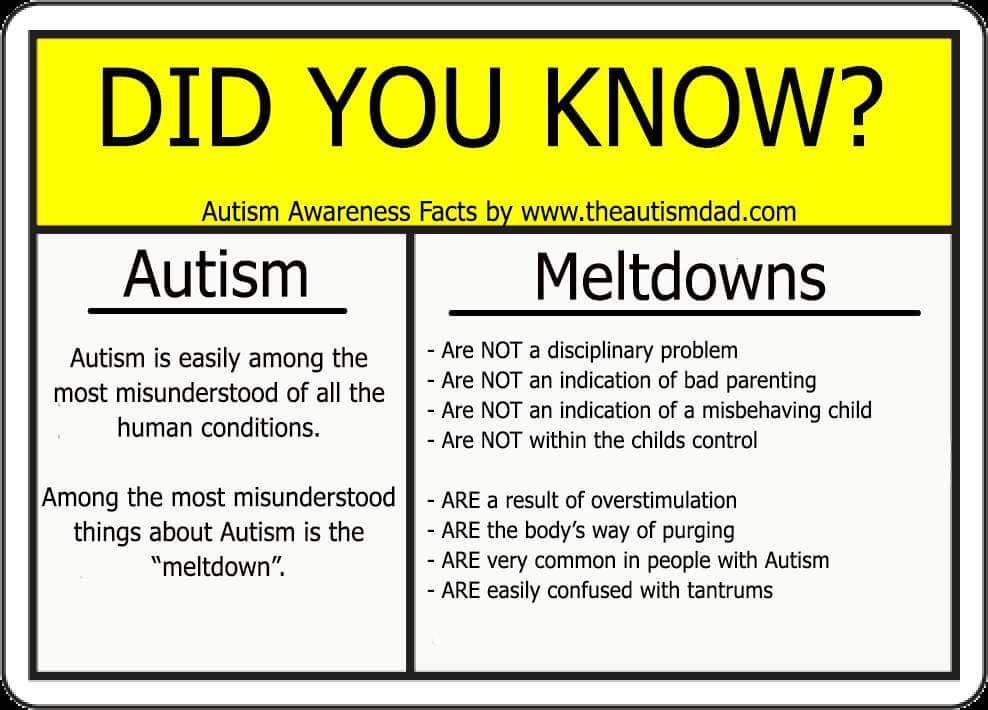In all my years of advocating from the perspective of an Autism parent, one of the most frequent, most frustrating and most misunderstood aspects has to do with meltdowns.
There are so many assumptions and so much judgement and misunderstanding surrounding meltdowns.
I put together a basic cheat sheet of sorts, that can be easily shared via social media. The purpose is to help dispel some of the assumptions and misunderstandings surrounding meltdowns. My hope is to promote a better understanding of what a meltdown is and what it is not.




What is the difference between bratty behavior (tantrum) and a meltdown? How can you tell? And what is the consequence for a meltdown vs a tantrum Because surely there must be something
The difference is really simple. A tantrum is meant to manipulate behavior. A kid throws a tantrum because they want something or aren’t getting their way. There are consequences for tantrums. Meltdowns occur because a child becomes so overwhelmed, usually by sensory input that they cannot process, that their bodies simply purge. There are no consequences for a meltdown because the child has absolutely no control over it.
Does that answer your question?
How can you tell the difference?
It’s usually pretty easy. If a child throws a tantrum, they have an end goal in mind. For example: a kid throws a tantrum because he wanted ice cream and didn’t get any. The tantrum is meant to try and get the ice cream by screaming until they get their way.
By contrast, a meltdown cannot be stopped once it’s begun. The child has absolutely no control over what’s happening and it’s almost worse for them to experience it than it is for a parent to live through it.
The difference is really simple. A tantrum is meant to manipulate behavior. A kid throws a tantrum because they want something or aren’t getting their way. There are consequences for tantrums. Meltdowns occur because a child becomes so overwhelmed, usually by sensory input that they cannot process, that their bodies simply purge. There are no consequences for a meltdown because the child has absolutely no control over it.
Does that answer your question?
How can you tell the difference?
It’s usually pretty easy. If a child throws a tantrum, they have an end goal in mind. For example: a kid throws a tantrum because he wanted ice cream and didn’t get any. The tantrum is meant to try and get the ice cream by screaming until they get their way.
By contrast, a meltdown cannot be stopped once it’s begun. The child has absolutely no control over what’s happening and it’s almost worse for them to experience it than it is for a parent to live through it.
The difference is really simple. A tantrum is meant to manipulate behavior. A kid throws a tantrum because they want something or aren’t getting their way. There are consequences for tantrums. Meltdowns occur because a child becomes so overwhelmed, usually by sensory input that they cannot process, that their bodies simply purge. There are no consequences for a meltdown because the child has absolutely no control over it.
Does that answer your question?
How can you tell the difference?
It’s usually pretty easy. If a child throws a tantrum, they have an end goal in mind. For example: a kid throws a tantrum because he wanted ice cream and didn’t get any. The tantrum is meant to try and get the ice cream by screaming until they get their way.
By contrast, a meltdown cannot be stopped once it’s begun. The child has absolutely no control over what’s happening and it’s almost worse for them to experience it than it is for a parent to live through it.
What is the difference between bratty behavior (tantrum) and a meltdown? How can you tell? And what is the consequence for a meltdown vs a tantrum Because surely there must be something
The difference is really simple. A tantrum is meant to manipulate behavior. A kid throws a tantrum because they want something or aren’t getting their way. There are consequences for tantrums. Meltdowns occur because a child becomes so overwhelmed, usually by sensory input that they cannot process, that their bodies simply purge. There are no consequences for a meltdown because the child has absolutely no control over it.
Does that answer your question?
How can you tell the difference?
It’s usually pretty easy. If a child throws a tantrum, they have an end goal in mind. For example: a kid throws a tantrum because he wanted ice cream and didn’t get any. The tantrum is meant to try and get the ice cream by screaming until they get their way.
By contrast, a meltdown cannot be stopped once it’s begun. The child has absolutely no control over what’s happening and it’s almost worse for them to experience it than it is for a parent to live through it.
The difference is really simple. A tantrum is meant to manipulate behavior. A kid throws a tantrum because they want something or aren’t getting their way. There are consequences for tantrums. Meltdowns occur because a child becomes so overwhelmed, usually by sensory input that they cannot process, that their bodies simply purge. There are no consequences for a meltdown because the child has absolutely no control over it.
Does that answer your question?
How can you tell the difference?
It’s usually pretty easy. If a child throws a tantrum, they have an end goal in mind. For example: a kid throws a tantrum because he wanted ice cream and didn’t get any. The tantrum is meant to try and get the ice cream by screaming until they get their way.
By contrast, a meltdown cannot be stopped once it’s begun. The child has absolutely no control over what’s happening and it’s almost worse for them to experience it than it is for a parent to live through it.
The difference is really simple. A tantrum is meant to manipulate behavior. A kid throws a tantrum because they want something or aren’t getting their way. There are consequences for tantrums. Meltdowns occur because a child becomes so overwhelmed, usually by sensory input that they cannot process, that their bodies simply purge. There are no consequences for a meltdown because the child has absolutely no control over it.
Does that answer your question?
How can you tell the difference?
It’s usually pretty easy. If a child throws a tantrum, they have an end goal in mind. For example: a kid throws a tantrum because he wanted ice cream and didn’t get any. The tantrum is meant to try and get the ice cream by screaming until they get their way.
By contrast, a meltdown cannot be stopped once it’s begun. The child has absolutely no control over what’s happening and it’s almost worse for them to experience it than it is for a parent to live through it.